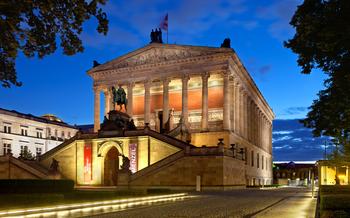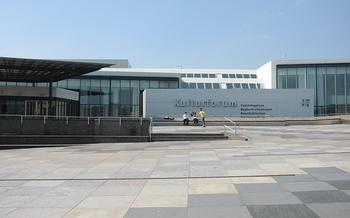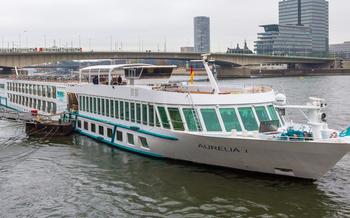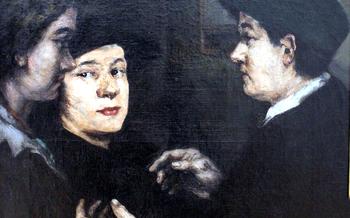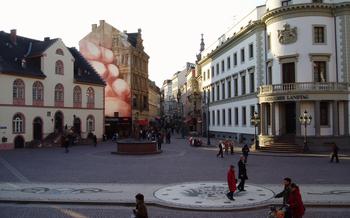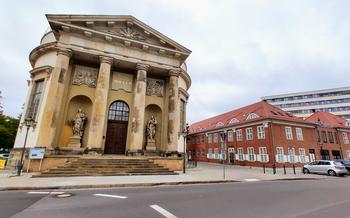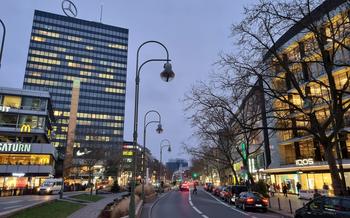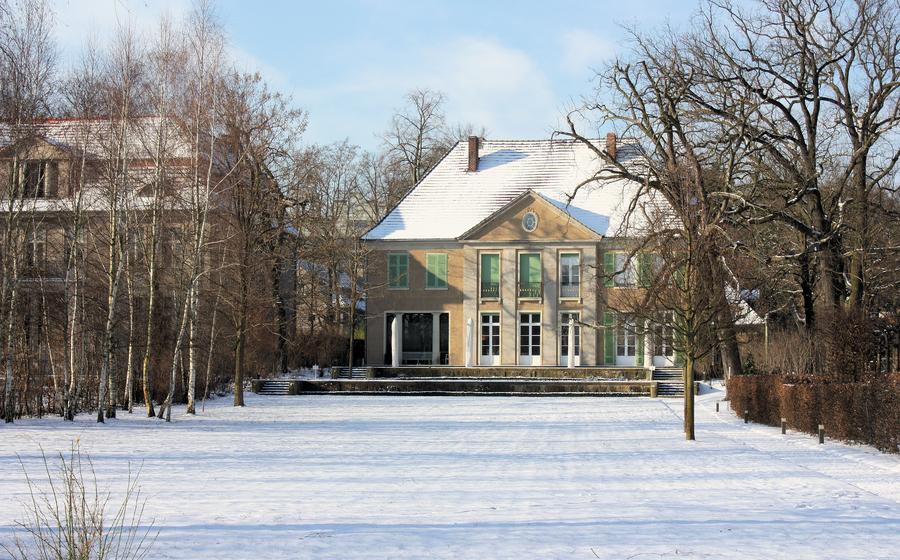
The Liebermann Villa at Wannsee
- The Liebermann Collection: A Treasure Trove of Art
- The Villa's Stunning Gardens: A Serene Oasis
- Guided Tours: Unveiling the Villa's Secrets
- Exhibitions and Events: A Dynamic Cultural Space
- Getting There: Convenient Transportation Options
- Hours of Operation: Planning Your Visit
- Admission Fees: Supporting the Villa's Preservation
- Audio Guides: Enhancing Your Experience
- Museum Shop: Unique Souvenirs and Gifts
- Café and Restaurant: Refreshment and Relaxation
- Accessibility: Ensuring Inclusivity for All
- Photography Guidelines: Capturing Memories
- Educational Programs: Engaging with Art and History
- Insider Tip: Hidden Gems of the Villa
The Liebermann Collection: A Treasure Trove of Art
The Liebermann Villa at Wannsee houses a remarkable collection of artworks that showcases the exceptional talent of Max Liebermann and other significant German artists. Liebermann, a prominent figure in the Impressionist movement, is renowned for his captivating landscapes, portraits, and urban scenes that capture the essence of turn-of-the-20th-century Berlin. His works, characterized by their vibrant colors, loose brushwork, and keen observation of light and shadow, offer a glimpse into the social and cultural milieu of his time.
The collection at the Liebermann Villa boasts a diverse range of paintings, sculptures, and drawings that span various periods of Liebermann's prolific career. Among the highlights are his iconic paintings such as "Garden Terrace in Wannsee" (1912), which depicts the idyllic surroundings of his beloved villa, and "The Beer Garden" (1892), a bustling depiction of a popular gathering spot in Berlin. Visitors can also admire Liebermann's masterful portraits, such as "Self-Portrait with Straw Hat" (1907), which reveals his introspective nature and artistic journey.
Beyond Liebermann's works, the collection at the Liebermann Villa also features pieces by other notable German artists, including Lovis Corinth, Edvard Munch, and Käthe Kollwitz. These works offer a broader perspective on the artistic landscape of Germany during the late 19th and early 20th centuries, providing visitors with a deeper understanding of the cultural and historical context of Liebermann's art.
Preserving and showcasing the Liebermann legacy is of utmost importance to the villa and its curators. The collection serves as a valuable resource for scholars, art enthusiasts, and the general public, ensuring that Liebermann's contributions to German art continue to be appreciated and celebrated for generations to come.
The Villa's Stunning Gardens: A Serene Oasis
The Liebermann Villa at Wannsee boasts breathtaking gardens that are a testament to Max Liebermann's love for nature and his artistic inspiration. Designed by renowned landscape architect Ludwig Lesser, the gardens are a harmonious blend of formal and informal elements, creating a serene oasis that complements the villa's architectural beauty.
Visitors are greeted by a meticulously manicured lawn, framed by vibrant flower beds bursting with color. Roses, peonies, and irises bloom in profusion, creating a fragrant tapestry that fills the air with their sweet scent. The gardens are a haven for a diverse array of plants and flowers, each carefully chosen for its aesthetic appeal and symbolic meaning.
Strolling through the gardens, visitors will discover hidden paths that lead to secluded corners, where they can pause and soak in the tranquility of the surroundings. Sculptures and fountains dot the landscape, adding a touch of whimsy and elegance. The gardens also feature a Japanese-inspired teahouse, where visitors can sip tea and contemplate the beauty of nature.
For Liebermann, the gardens were not just a source of inspiration but also a place where he could relax and recharge. He often painted en plein air, capturing the changing seasons and the play of light and shadow on the gardens' lush greenery. The gardens were an extension of his artistic vision, a living canvas that reflected his deep appreciation for the natural world.
Today, the gardens remain a popular spot for visitors to relax, reflect, and immerse themselves in the beauty of nature. Whether you're an art enthusiast seeking inspiration or simply looking for a peaceful retreat, the Liebermann Villa's gardens offer a serene oasis that will leave you feeling refreshed and rejuvenated.
Guided Tours: Unveiling the Villa's Secrets
Embark on a journey through time as you join a guided tour of the Liebermann Villa at Wannsee. These immersive experiences, led by knowledgeable guides, offer a deeper understanding of the villa's history, architecture, and art collection.
Highlights and Insights:
-
Historical Context: Delve into the villa's fascinating past, from its construction in 1909 to its role during the Nazi era and its subsequent restoration.
-
Architectural Details: Admire the villa's unique architectural features, including its Jugendstil elements and the integration of natural surroundings.
-
Art Collection: Explore the significance of Max Liebermann's work and gain insights into the artistic movements that shaped his style.
-
Personal Stories: Hear captivating stories about the Liebermann family and their circle of friends, including famous artists, writers, and musicians.
Types of Tours:
-
Standard Guided Tour: A comprehensive overview of the villa's history, architecture, and art collection, lasting approximately 60 minutes.
-
In-Depth Tour: A more detailed exploration of specific themes or aspects of the villa, lasting approximately 90 minutes.
-
Group Tours: Customized tours for groups of 10 or more, with flexible itineraries and special arrangements.
Duration and Cost:
-
Standard Guided Tour: Approximately 60 minutes, with a fee of 12 euros per person.
-
In-Depth Tour: Approximately 90 minutes, with a fee of 15 euros per person.
-
Group Tours: Pricing and arrangements vary depending on group size and requirements.
Advance Booking:
To secure your spot on a guided tour, especially during peak seasons or for specific themes, advance booking is highly recommended. Reservations can be made online or by phone.
Unveiling the Villa's Secrets:
Join a guided tour of the Liebermann Villa at Wannsee and uncover its hidden treasures. With knowledgeable guides leading the way, you'll gain a deeper appreciation for this architectural and cultural gem.
Exhibitions and Events: A Dynamic Cultural Space
The Liebermann Villa at Wannsee is not just a museum; it's a vibrant cultural hub that hosts a diverse range of exhibitions and events throughout the year. These events bring the villa's collection and history to life, offering visitors a deeper understanding and appreciation of German art and culture.
Exhibitions at the villa typically focus on the work of Max Liebermann and his contemporaries, showcasing their artistic styles and techniques. The villa has also hosted exhibitions on other prominent German artists, as well as on specific themes related to German art and history.
In addition to exhibitions, the villa also hosts a variety of events, such as concerts, lectures, and workshops. These events provide opportunities for visitors to engage with the villa's collection and history in a more interactive way. Concerts often feature performances of classical music or jazz, while lectures and workshops cover topics related to art, history, and culture.
For the most up-to-date information on current and upcoming exhibitions and events, visitors are encouraged to check the villa's website. Event schedules and ticket information are available online, and advance booking is recommended to secure a spot.
Whether you're interested in art, history, or simply looking for a unique cultural experience, the Liebermann Villa at Wannsee is sure to have something to offer. Its diverse range of exhibitions and events makes it a dynamic and engaging destination for visitors of all ages.
Getting There: Convenient Transportation Options
Reaching the Liebermann Villa at Wannsee is a breeze, with various transportation options available. For those opting for public transport, the S-Bahn (suburban railway) offers direct access to the villa. The S7 line stops at the Wannsee station, just a short walk away from the villa's entrance. Alternatively, several bus lines, including the 114, 218, and 316, provide convenient connections to the villa from different parts of Berlin.
If you prefer the flexibility of driving, the villa is easily accessible by car. Simply follow the signs to Wannsee and look for the villa's address, Liebermann-Villa, Colomierstraße Ample parking spaces are available on-site, ensuring a hassle-free visit.
For those with limited mobility, the villa offers designated accessible parking spaces close to the entrance. Additionally, the villa's grounds and exhibition spaces are wheelchair accessible, allowing visitors to navigate comfortably.
Hours of Operation: Planning Your Visit
Planning your visit to the Liebermann Villa at Wannsee is crucial to ensure a smooth and enjoyable experience. The villa's opening hours are currently from Tuesday to Sunday, 10 am to 6 pm, allowing ample time to explore its various attractions. Do note that the villa may have seasonal variations in its operating hours, so it's advisable to check their website or contact them directly for the most up-to-date information.
When deciding on the best time to visit, consider the following factors:
-
Morning hours (10 am to 12 pm) are ideal for avoiding crowds, especially during the peak tourist season. This allows you to explore the villa and its gardens at a leisurely pace and take advantage of the natural light for photography.
-
Late afternoon (4 pm to 6 pm) can be a good option if you prefer a quieter atmosphere, as the crowds tend to thin out closer to closing time. This can be an excellent opportunity to soak in the tranquility of the gardens and reflect on your experience.
-
Weekdays (Tuesday to Friday) are generally less crowded compared to weekends, particularly during the summer months. If you're looking for a more intimate and personalized visit, consider planning your trip for a weekday.
Remember to factor in enough time to explore the villa's various offerings, including the collection, gardens, exhibitions, and any special events or guided tours that may be taking place during your visit.
Admission Fees: Supporting the Villa's Preservation
Admission fees for the Liebermann Villa at Wannsee contribute to the preservation and maintenance of this historic site. The current prices are as follows:
- Adults: 10 euros
- Children (6-18 years old): 5 euros
- Concessions (students, seniors, disabled visitors): 8 euros
The admission fee includes a guided tour of the villa, which provides valuable insights into the history, architecture, and collection of the Liebermann family. Visitors can also explore the villa's stunning gardens and participate in various exhibitions and events throughout the year.
Discounts and special offers are available for groups, students, and seniors. It is also possible to purchase advance tickets online to save time and money. These tickets can be easily booked through the villa's website.
By paying the admission fee, visitors not only gain access to a wealth of cultural treasures but also contribute to the ongoing preservation of this important heritage site. The Liebermann Villa relies on the support of visitors to continue its mission of promoting art, history, and education.
Audio Guides: Enhancing Your Experience
Enrich your visit to the Liebermann Villa by renting an audio guide, available in multiple languages for a comprehensive and informative experience. These guides provide insightful commentary on the villa's history, architecture, and the Liebermann family's contributions to German culture.
With an audio guide in hand, you'll gain a deeper understanding of the artwork on display, including Max Liebermann's famous paintings and sculptures. The audio guides also shed light on the historical significance of the villa, its role during the Nazi era, and its current status as a museum and memorial site.
Renting an audio guide is an excellent way to enhance your visit, especially if you're particularly interested in art history or German culture. The cost of renting an audio guide is reasonable, and you can pick it up at the villa's entrance. Whether you choose to explore independently or with the assistance of an audio guide, the Liebermann Villa promises a captivating and memorable experience for all visitors.
Museum Shop: Unique Souvenirs and Gifts
The Liebermann Villa's museum shop is a treasure trove of unique souvenirs and gifts inspired by the Liebermann collection and the villa's history. Here, you can find a variety of items, including books, postcards, and replicas, that will serve as lasting mementos of your visit.
The shop offers a carefully curated selection of art books, catalogs, and monographs that delve into the life and work of Max Liebermann and his contemporaries. These publications provide a deeper understanding of the artistic movements and influences that shaped Liebermann's style.
For those seeking tangible reminders of their visit, the shop offers a range of postcards featuring reproductions of Liebermann's most famous paintings. These postcards are perfect for sending to friends and family or for creating a personal collection of art.
If you're looking for a more unique souvenir, the shop also sells replicas of some of Liebermann's works. These high-quality reproductions are created using the same techniques and materials as the originals, making them a valuable addition to any art collection.
By making a purchase at the museum shop, you not only take home a piece of the Liebermann Villa's legacy but also contribute to the preservation and maintenance of this important cultural institution.
Café and Restaurant: Refreshment and Relaxation
Amidst your exploration of the Liebermann Villa, you may find yourself seeking sustenance and a moment of relaxation. Fortunately, the villa offers both a café and a restaurant to cater to your needs.
The café, located within the villa, provides a cozy and inviting atmosphere to enjoy a light snack or a refreshing beverage. Sip on a warm cup of coffee or tea while indulging in a freshly baked pastry or a delectable sandwich. During the warmer months, take advantage of the outdoor seating area to savor your treats while soaking in the tranquil ambiance of the villa's gardens.
For a more substantial meal, the villa's restaurant offers a menu featuring a range of dishes, from traditional German cuisine to international fare. Whether you're in the mood for a hearty schnitzel, a flavorful pasta, or a crisp salad, you're sure to find something to satisfy your appetite. The restaurant also offers a selection of wines and beers to complement your meal.
To ensure a smooth and enjoyable dining experience, reservations are recommended, especially during peak hours. Whether you choose to dine in the café or the restaurant, you'll find a welcoming atmosphere and attentive service, making your visit to the Liebermann Villa a truly memorable one.
Accessibility: Ensuring Inclusivity for All
The Liebermann Villa at Wannsee is committed to providing an accessible and welcoming environment for all visitors. To ensure a comfortable and enjoyable experience for everyone, the villa offers a range of accessibility features and services.
Designated accessible parking spaces are available for visitors with disabilities, located conveniently near the villa's entrance. Ramps and elevators provide easy access to all levels of the villa, allowing visitors with mobility challenges to navigate the building without difficulty.
Upon request, visitors with special needs can receive assistance from the villa's staff. Trained personnel are available to provide guidance, directions, and any necessary support to ensure a smooth and enjoyable visit for all.
The villa's commitment to inclusivity extends to its educational programs and events. Educators and facilitators are trained to accommodate the needs of diverse learners, creating an environment that is welcoming and supportive for all participants.
By providing accessibility features and services, the Liebermann Villa strives to create a space where everyone can engage with art, history, and culture without barriers.
Photography Guidelines: Capturing Memories
Photography enthusiasts are welcome to capture the beauty of the Liebermann Villa and its surroundings. However, certain guidelines must be followed to ensure the preservation of the artwork and the privacy of other visitors.
Generally, photography is permitted in the villa's public areas, including the gardens. However, using flash photography or tripods is prohibited to avoid damaging the delicate artworks. Additionally, photography is not allowed in certain areas, such as the conservation studio or during special events.
Visitors are encouraged to be respectful of other guests and the artwork on display. Avoid blocking the views of others or disturbing the peaceful atmosphere of the villa. When in doubt, it's always best to ask a member of the staff for guidance.
By following these guidelines, visitors can capture their memories of the Liebermann Villa while respecting the artwork and the rights of others.
Educational Programs: Engaging with Art and History
The Liebermann Villa offers a variety of educational programs designed to engage visitors of all ages with art, history, and culture. These programs are tailored to different audiences, including school groups, families, and adult learners.
For school groups, the villa provides guided tours, workshops, and interactive activities that align with educational curricula. Students can learn about the history of the villa, the life and work of Max Liebermann, and the significance of Impressionism in German art.
Families can participate in special family days, weekend workshops, and art-themed activities. These programs provide a fun and engaging way for parents and children to explore the villa's collection and gardens together.
Adults can attend lectures, seminars, and discussion groups on topics related to art, history, and culture. These programs offer opportunities for in-depth exploration and intellectual exchange.
To participate in educational programs, advance booking is required. Visitors can check the villa's website or contact the education department for more information and to make reservations.
These educational programs enhance the visitor experience by providing opportunities for hands-on engagement, deeper learning, and meaningful discussions. They help to foster a greater appreciation for art, history, and culture, inspiring visitors to continue their exploration beyond the walls of the Liebermann Villa.
Insider Tip: Hidden Gems of the Villa
Beyond the main attractions of the Liebermann Villa, there are hidden gems waiting to be discovered by curious visitors. One such gem is the villa's secret garden, tucked away behind the main building. This secluded oasis features a variety of rare and exotic plants, creating a tranquil and intimate atmosphere. Visitors can stroll along the winding paths, admire the colorful blooms, and find a quiet spot to relax and reflect.
Another hidden gem is the villa's attic, which houses a collection of Max Liebermann's personal belongings and memorabilia. Here, visitors can gain a glimpse into the artist's life and creative process through his sketchbooks, letters, and other artifacts. The attic is not always open to the public, so it's worth checking in advance to see if it's accessible during your visit.
For those interested in photography, the villa's gardens offer a wealth of hidden photographic opportunities. From the vibrant colors of the flowers to the intricate details of the sculptures, there are countless subjects to capture. Visitors are encouraged to explore the gardens with a keen eye and to experiment with different angles and perspectives to capture unique and memorable shots.
Whether you're looking for a quiet retreat, a glimpse into the artist's life, or simply a chance to capture some stunning photographs, the Liebermann Villa's hidden gems are waiting to be discovered. Take the time to explore beyond the main attractions and you'll be rewarded with a truly unforgettable experience.
